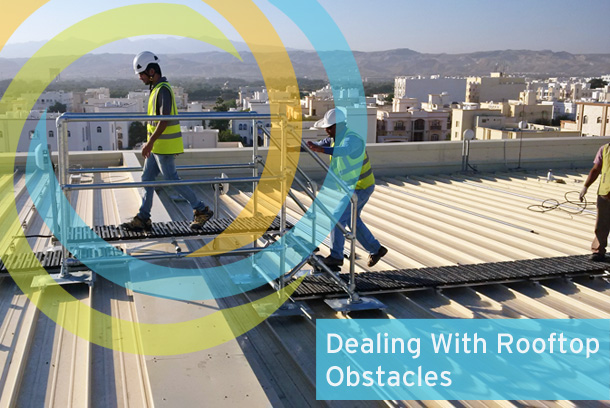Accessing Rooftop Obstacles with Crossover Stairs

We’ve spent a good deal of time in past blog posts discussing the hazards associated with falls from rooftops. There’s good reason for that, of course, as it is a pervasive and potentially deadly hazard, but as safety professionals, we must be sure to mitigate all recognized hazards, not just the biggest or potentially most severe ones. While some rooftops are simple and flat structures, not all of them are. Interior parapets, pipes, conduits, skylights, birds, and a variety of other things pose potential threats to employees. Even walking on the metal decking when a roof is under construction is a trip hazard.
Nature of the Problem
According to the US Department of Labor, slips, trips, and falls account for the majority of general industry accidents. They account for 15% of all accidental deaths (second only to motor vehicle accidents). These fall hazards exist not only at the edge of roofs and at skylights but wherever a fixed object is present in the path of travel. Getting around these obstacles often ends up with workers climbing, hopping, and jumping rather than walking safely.
Trust me when I tell you that construction workers, maintenance personnel, and others who may have a need to access your roof might not be the most nimble bunch. Anything that has them doing acrobatics just to get to their work area is a problem.
Many facilities will ignore these hazards for the same reasons you always hear: “Oh, we’re not up there that often,” or, “Only contractors go up there, not our personnel,” or, “Well, it’s too late to worry about it now, we’re already up here in the middle of the work.” These are not acceptable reasons and, if you’re hearing them from your management, you need to work to change the culture. Pre-job planning is important. Contractor safety is important. Employee safety is important, no matter how infrequent or brief the work.
Solving the Problem
If you’re one of the lucky ones that have the ear of - and full support from - your management, your next step is to navigate the murky waters of hazard mitigation. You have options. For many of these obstacles, crossovers and safety platforms are easily your best solutions. And, since roof structures tend to not change, if you make or purchase your roof crossover platforms properly, many can be left in place indefinitely so that you don’t need to fix the problem every time you perform a task on the roof.
Most of these structures can be installed in minutes and can be fully customized to what you need. From a small ramp that crosses a run of conduit, to a platform with stairs that bridges two roof sections, to the walkways you need to get to and from your access points, you can find pre-fabricated, modular access platforms to solve all of these issues.
Work platforms cannot just be thrown together without any particular care given to their construction. Work platforms of any kind are governed by portions of the OSHA standard, specifically 29 CFR 1910 Subpart D – “Walking and Working Surfaces”. If you’re going to build your own, pay special attention to this part as it will direct you on how to build railings, how strong, how wide, and at what angle stairs need to be, what type of material the treads must be made out of, and more (see 29 CFR 1910.28 for more information).
Purchasing them pre-constructed may save you some headaches and will probably yield a more durable product. Based on your needs, check out the following list:
- Total Modular Platform - installed as-is and hard to customize, but you may find one that suits you.
- Fabricated Pre-Engineered Platform - designed and then built exactly as needed. These often take much longer to obtain, but they are exactly what you need.
- Custom Safety Platform - uses some modular pieces that are then customized to your location/task/etc. These are obtained faster, are easier to replace, modify, or fix, and are designed to meet your exact needs.
So the question becomes, with all of these options, why are your employees still jumping and climbing? Next time you go on your roof, take note of all the trip and fall hazards your employees and contractors are exposed to. Better yet, make it a point to go up there and check now, before any more rooftop work is done. Get the wheels rolling now so that by the time there’s a need to be up there, your people are safe.



